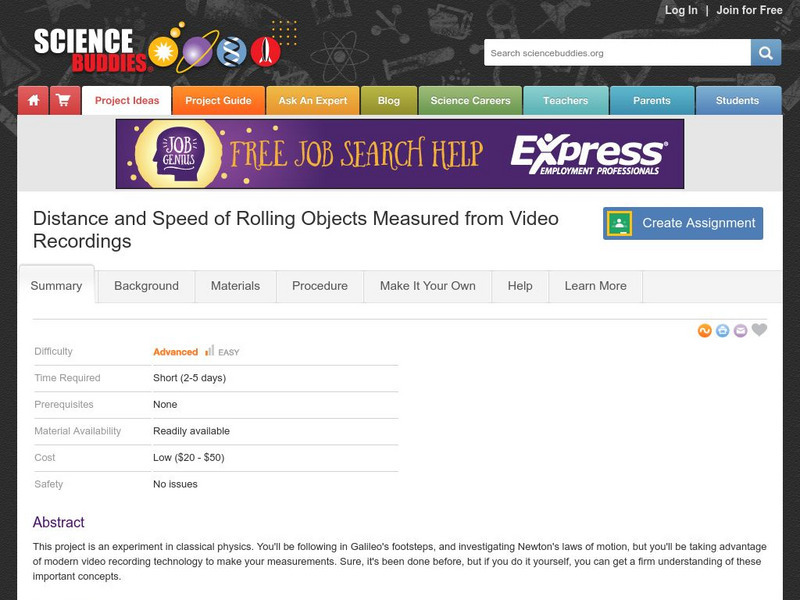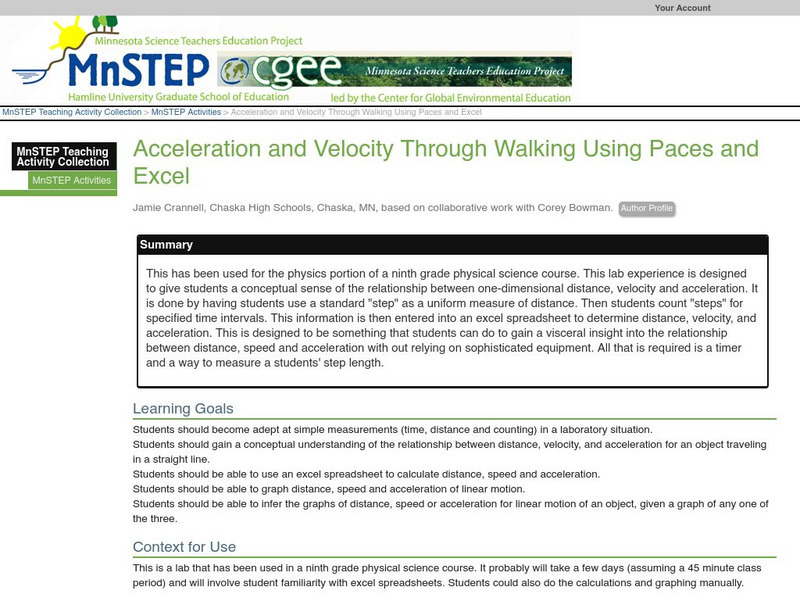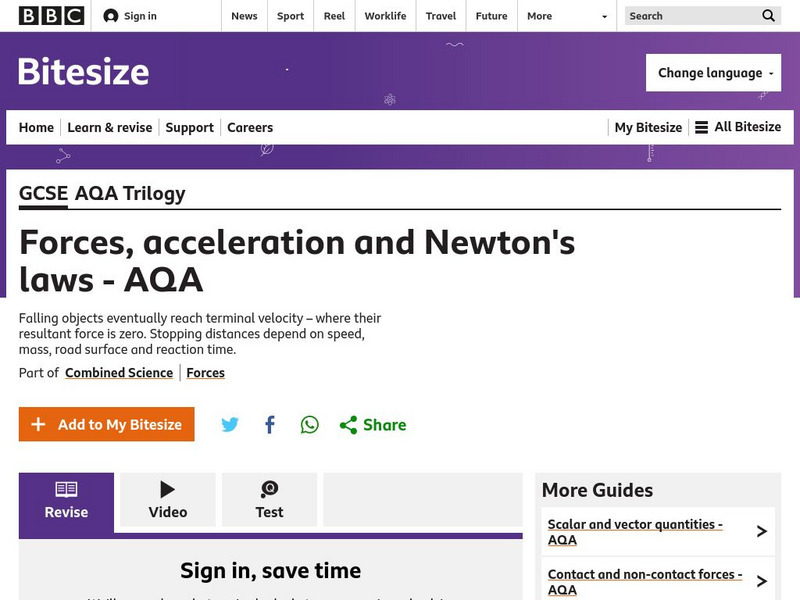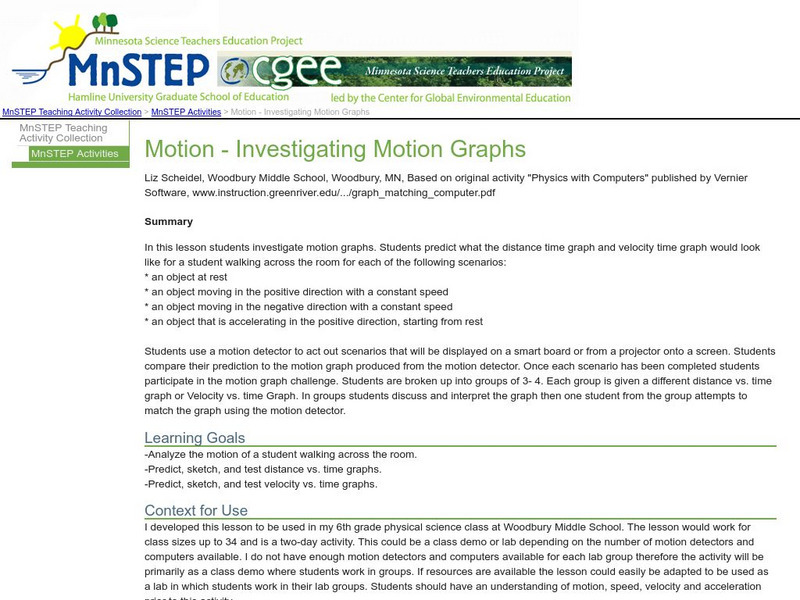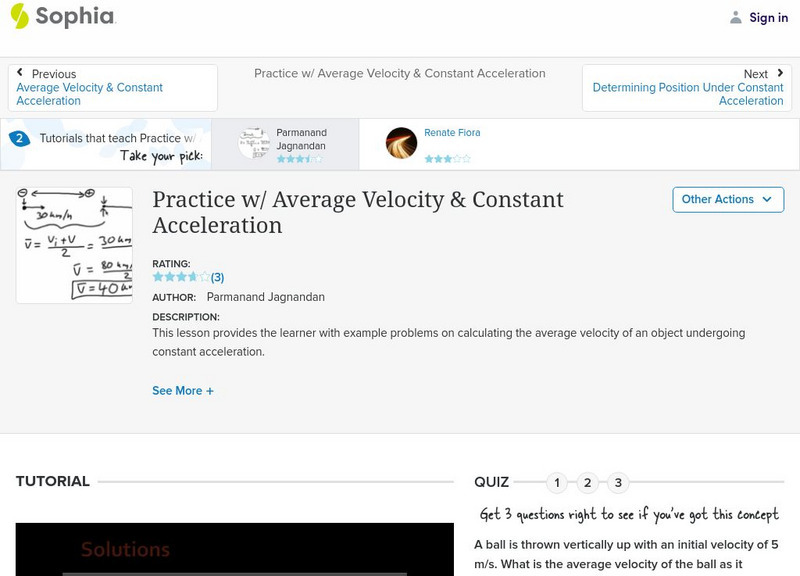PBS
Pbs Learning Media: Virtual Car: Velocity and Acceleration
Take control of a virtual car and learn how vectors are used to represent velocity and acceleration in this interactive activity developed for Teachers' Domain.
Khan Academy
Khan Academy: What Is Centripetal Acceleration?
Learn what centripetal acceleration means and how to calculate it. Included are two example problems with solutions.
Physics Aviary
Physics Aviary: Acceleration Challenge
Challenges students to get as many vehicle accelerations as possible in a 3 minute time frame. Students must push on the gas to accelerate their vehicle and then use the change in velocity and the change in time to get the acceleration...
Texas Education Agency
Texas Gateway: Objects in Motion
This resource provides flexible alternate or additional learning activities for students learning about the concepts of distance, speed, and acceleration.
Khan Academy
Khan Academy: Acceleration and Velocity
This site includes practice using the acceleration equation to solve for acceleration, time, and initial or final velocity.
Khan Academy
Khan Academy: What Are Velocity vs. Time Graphs?
How to analyze graphs that relate velocity and time to acceleration and displacement.
Physics Aviary
Physics Aviary: Circular Acceleration
This program gives students a visual representation of why an object moving in a circle at constant speed is accelerating. This program will guide students through a method of calculating the circular acceleration based on the change in...
Khan Academy
Khan Academy: Acceleration: At a Glance
This article talks about how acceleration is the change of velocity as time passes anytime we speed up or slow down, or change direction, we undergo acceleration.
Other
Institute of Physics: Practical Physics: Speed Time Graphs to Find an Equation
An illustrated example of a speed-time graph plotted with speed on the vertical axis against time on the horizontal axis.
Science Buddies
Science Buddies: Distance and Speed of Rolling Objects
This project is an experiment in classical physics. You'll be following in Galileo's footsteps, and investigating Newton's laws of motion, but you'll be taking advantage of modern video recording technology to make your measurements. The...
Science Education Resource Center at Carleton College
Serc: Using Velocity and Acceleration Vectors to Interpret the Motion of a Car
Students understand that vectors have both magnitude and direction components as they investigate velocity and acceleration vectors.
Physics Classroom
The Physics Classroom: 1 D Kinematics: Acceleration vs. Constant Velocity
Observe the animation of the three cars. Use the animation to answer three questions about their acceleration and velocity.
Physics Classroom
The Physics Classroom: 1 D Kinematics: Rightward Velocity and Acceleration
Through an animated illustration of a dot diagram and time graphs, students learn about positive velocity and positive acceleration.
Science Education Resource Center at Carleton College
Serc: Acceleration and Velocity Through Walking Using Paces and Excel
This has been used for the physics portion of a ninth grade physical science course. This lab experience is designed to give students a conceptual sense of the relationship between one-dimensional distance, velocity and acceleration.
Science Education Resource Center at Carleton College
Serc: Graph Predictions for Position, Velocity and Acceleration
Learners interactively create predictions of position, velocity, and acceleration graphs using java applets. The applets automatically classify student answers, so instructors can create graphs of student predictions.
Science Education Resource Center at Carleton College
Serc: Investigating Speed and Velocity
In this investigation, middle schoolers will work in groups to design a model roller coaster, which will be used to clock the fastest speed for the rider (ball bearing/marble) The groups will build roller coaster models and modify and...
BBC
Bbc: Gcse Bitesize: Forces, Acceleration and Newton's Laws Aqa
This lesson focuses on Newton's First Law: an object remains in the same state of motion unless a resultant force acts on it. If the resultant force on an object is zero, this means: a stationary object stays stationary; a moving object...
Khan Academy
Khan Academy: Position, Velocity and Acceleration
This 9-problem quiz/practice helps students understand how position, velocity and acceleration are related.
Physics Classroom
The Physics Classroom: 1 D Kinematics: Table of Contents
Learners examine motion with words, equations, diagrams, and graphs. Some topics investigated are position, velocity, acceleration, and free fall. The tutorial consists of lessons and problems to check for understanding.
Middle School Science
Middle School Science: Motion Notes
Personal site in which a teacher outlines a unit on motion. Probes through topics such as average speed, velocity, acceleration, speed, deceleration, force and more.
Science Education Resource Center at Carleton College
Serc: Analyzing the Motion of a Marble Down a Ramp
This lab activity involves rolling a marble down a ramp where the students can investigate constant acceleration motion. The students then make a position vs. time graph and a velocity vs. time graph in order to investigate the change in...
Physics Classroom
The Physics Classroom: 1 D Kinematics: Meaning of Slope for a v T Graph
In this part of a physics lesson, examine how the actual slope value of any straight line on a velocity-time graph is the acceleration of the object.
Science Education Resource Center at Carleton College
Serc: Motion: Investigating Motion Graphs
In this lesson, students investigate motion graphs. Students predict what the distance-time graph and velocity time graph would look like for a student walking across the room for three different scenarios.
Sophia Learning
Sophia: Practice W/ Average Velocity & Constant Acceleration: Lesson 1
This lesson provides the learner with example problems on calculating the average velocity of an object undergoing constant acceleration. It is 1 of 2 in the series titled "Practice w/ Average Velocity & Constant Acceleration."









